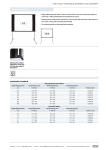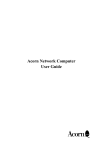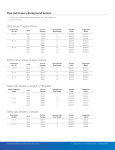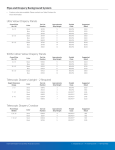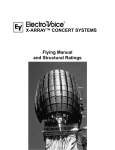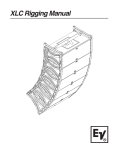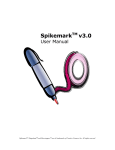Download stage equipment and curtains
Transcript
STAGE EQUIPMENT AND CURTAINS OPERATION AND SERVICE MANUAL GRAND STAGE LIGHTING/ ART DRAPERY STUDIOS 630 WEST LAKE STREET CHICAGO, IL, 60661-1465 PHONE: (312) 332 5611 FAX: (312) 332 3655 URL: WWW.GRANDSTAGE.COM DRAPERY DESCRIPTION All curtain systems fall into to general categories most easily described as the front setting and the rear setting. The front setting is composed of the act curtain (main) and everything in front of it. This would include such drapery as the grand valance, acoustic drapery used in the house, side stage tab curtains, etc. The rear setting would include all onstage travelers (mid-stage and rear), all border curtains, side masking curtains (legs, tabs) and rear masking curtains (sky drops, cycloramas). The principle function of the rear setting is to define the performance area. The function of the front setting is to reveal the performance and to signal the end. In most cases the grand valance and the main are constructed from the same fabric chosen to provide an elegant look to the auditorium. The rear serves the utilitarian function of masking the working areas of the stage from the audience. Color of the rear setting tends to the darker hues, such as black or blue while the front setting is chosen for its ability to complement the decor of the auditorium. FIRST CURTAIN OPERATION The Grand (the main or the act) can be a straight-lift curtain (guillotine), a contour curtain (roman, tableau, waterfall, profile), motorized, hand operated, or traditional bi-parting. Regardless of type, all first curtains serve the same function, to reveal the production to the audience for the first time, to indicate the interval and to signal the end of the performance. When the Main curtain is to be opened to predetermined positions, the operating line should be “spiked” with yarn or string. Never use tape on the operating line! At worst the tape will become fouled in the carriers or in the live and/or dead end pulleys. At best the tape will leave a residue from the adhesive used to hold the tape. This residue will collect dirt and other contaminants, which will eventually foul in the carriers and pulleys. Spiking the line requires a large upholstery needle and colored yarn or string. The process of spiking a hand line is simple; first, move the curtain to the desired position. Once in position, using the threaded upholstery needle, pull the needle and colored yarn through one of the operating lines at a convenient height (usually at operator eye level). Using the second color repeat the process on the other line. It is important that both marks are at the same elevation. When both colors are level to one another the desired curtain position has been achieved. The reason for marking both lines is that one colored line will serve as a warning that the desired location is nearing thus allowing for precise positioning. If tape spiking is the only method then ONE WRAP around the operating line is enough and immediate removal once the event is over. The previously discussed information applies only to bi-parting hand operated curtains. All motorized curtains require either programmable stops or close observation by the operator who has a hand on the stop button. Lifting curtains (guillotine) are usually bi-parting and can Grand Stage Lighting Company, Inc. Rev. 1.2 -2- be flown above the proscenium arch or slightly above the bottom grand valance. Contour curtains, because of the many lifting lines and their weight, are usually motorized. GENERAL CURTAIN OPERATION Moving a drape along a track should be effortless and quiet. Depending on the weight of the curtain, you will experience slightly different feelings of weight requiring different effort for smooth operation. However, if the operation feels difficult or if the carriers bind up in the track, it is likely that a foreign object has gotten into the track channel or one of the carriers has broken. Under no circumstances lubricate track or carriers. Lubrication will only solve a short term problem. Once the lubricant begins to absorb the dirt and dust from the atmosphere, the operation of the curtain will become increasingly more difficult until the drapery will no longer operate and the track and components will have to be replaced. The stage drapery track is a formed steel or aluminum channel in which the carriers travel or extruded aluminum “I” beam on which carriers travel. The pulleys are permanently lubricated and appropriately sized for the operating line (hand line). The curtain carriers have nylon or steel bodies and polyethylene wheels. They are supported by ball or sleeve bearings, and require no lubrication. The hand line (on draw curtains) is black spun polyester or braided cotton sash cord. BI-PARTING CURTAINS A gentle and smooth pull on the operating line, usually located on the stage right side of the track, is all that is required to open or close the curtain. Moving a drape along a track should require only minimal effort. Depending on the size and weight of the curtain, greater or lesser effort will be required for smooth operation. However, if the operation feels difficult or if the carriers bind up in the track a problem exists which requires immediate attention. In all likelihood a foreign object has gotten into the channel, one of the carriers has broken or spike tape has fouled one of the carriers. Do not attempt to make repairs until you have called your GSL/ads representative for detailed instructions on the repair WALK-ALONG CURTAINS Drapery on walk-draw tracks should move effortlessly. When moving smaller walk-draw curtains the fabric should be bunched together so that you can get both arms around the stack before moving it along the track. Walk the drape to the desired location by pushing the stack to the center of the desired position. Once at the desired location, then draw the curtain out to the sides by grasping trailing or leading edges (from the back) and pulling each panel flat. On large curtains it is best to bunch the curtain together, move it to the center, dropping portions of the curtain off at random locations along the track. Once this process is completed do the final positioning and dressing of the curtain. Grand Stage Lighting Company, Inc. Rev. 1.2 -3- PIVOTING LEGS This curtain is located on the sides of the stage and serves as an adjustable masking curtain. The pivot is a special carrier, which allows the angle of the curtain, as it relates to the proscenium, to be changed. When moving a leg, first pivot the drapery support pipe into a position parallel with the track. This is accomplished by using the fabric to rotate the pipe into position. The curtain is moved by grasping the edge of the curtain and gently pushing the drape to the desired location. Care must be taken in this operation so that the curtain does not become fouled in other curtains or scenery. Great care must be exercised when moving the curtain near stage lighting fixtures. Heat from these fixtures will scorch the fabric over time. MOTORIZED CURTAINS Motorized curtains require close observation when in use. The operator’s hand must be poised above the stop button and eyes on the curtain as it moves along the track. Since the operator has no tactile feed back it is very difficult to determine problems, thus the admonition of “one hand above the stop button”. Curtain machines continue to operate as long as electricity flows. Carriers will break, drapery will tear, anything in the path will do damage to the moving curtain until the lead carrier reaches the limit switch or the machine is shut down. In short, never push the go button and walk away. DRAPERY AND TRACK MAINTENANCE The principle concept of track and drapery maintenance is simple inspection and immediate repair. DRAPERY If the drapery is to be taken down, clean the stage by dry mopping, then lay plastic on the deck under the drape. Lower the drape onto the plastic, when possible pulling the bottom downstage so the drape lies with face fabric up. GSL/ads suggests the drapes be folded "seam to seam" for storage. To fold drapery "seam to seam", stretch the drape flat and have a technician kneel at the top and a second technician kneel at the bottom of the drape near the leading edge. Both people should take the first seam at the same time and pull it toward the side hem. Repeat this until the drape has been folded. Then take the bottom and fold it to the middle and take the top and fold it to the middle. Repeat this until the drape is the correct size for easy storage. Store the folded drapery in a cool dry place off the floor. GSL/ads does not recommend stacking folded drapery. When the drapery is to be re-installed allow several days for the drapery to “hang out” in its new location. Inspect the drapery for dirt and tears after every performance. All drapery must be inspected thoroughly by a knowledgeable dry cleaner (a firm which handles stage drapery as a regular part of business). Please call GSL/ads for Grand Stage Lighting Company, Inc. Rev . 1.2 -4- recommendations. The inspection must be done on a regular basis. The dry cleaner will be able to determine whether the drapes need to be re-treated with flame retardant chemicals. Plan on a major "in house" inspection once a year, and to have the curtain re-certified for flame resistance every two years (required by most fire codes, see 41). Re-certification is done by drapery cleaning companies certified for commercial flame retardant application by immersion. Some cleaners will indicate that the drapery can be cleaned and treated on site. This is not an acceptable method as the cleaning will remove the retardant chemicals and it is not possible to apply the retardant evenly using a spray. Flame resistant does not mean flameproof. When the drapery begins to tear easily, fray on its own, or begins to rip free of it’s heading, it must be replaced. These are signs of dry rot, the plague of all natural fabrics, which have been treated for flame resistance. The only cure is replacement. Some stage fabric is inherently flame retardant and, as a result, requires no special flame retardant treatment just normal cleaning and maintenance. These fabrics are usually synthetic rather than cotton. All stage drapery requires a label, usually at eye level on the trailing edge of the curtain, indicating the manufacturer, the date of manufacture and the date of the flame retardant immersion, or a statement of inherent flame resistance. GSL/ads places these tags on the offstage edge of the curtain approximately four feet above the stage floor on a flap made from the face fabric. The flap allows the inspector to test for flame resistance by cutting a sample from the flap rather than the curtain itself. The methods of attaching drapery to the various support devices are with tie lines, snap hooks or "S" hooks. When a tie line is used, the preferred method is to fold the tie line in half, insert the fold into the grommet located at the top of the curtain and to pass the ends through the loop, thus creating a "loop hitch". The two free ends are then wrapped around the batten and tied with a bow knot. When using "S" hooks, the hook is passed into the grommet and squeezed shut. The other portion of the hook is inserted into the trim chain of the carrier and squeezed shut. For border curtains pipe hooks are often used. The hook is attached to the curtain through the grommet but the other end of the hook is snapped over the batten. When pipe hooks are used, they must be sized according to the diameter of the pipe. Most cyclorama curtains are 100% cotton muslin or canvas duck. It is often unbleached to provide an even neutral surface for color washes of light from the front. Other fabric colors that are sometimes used are gray, blue, white and pale green. The cyc has also been flameretarded by the immersion process. Extreme care should be used in handling this curtain, since the light color will show any marks more readily than the velour. If the drop needs to take it down for any reason, remove the bottom weight pipe by pulling it out from either side of the bottom pocket and repeat the procedure described previously. Grand Stage Lighting Company, Inc. Rev. 1.2 -5- A scrim requires great care when in use. Since this curtain type has a very loose weave the potential for snagging on other scenic units is great. This family of drapery is the most fragile and requires the greatest care when stored and when in use. Prior to storing, scrims must be folded, stored in a protective bag and kept dry. It is not recommended to store scrims and other open weave drapery in the fly loft. Since this type of drapery is sewn flat and designed to hold a weight pipe in the bottom hem, it will stretch. Once the fabric is torn, it cannot be invisibly mended, only made smaller. The operational caveat is "user beware". TRACKS Drapery tracks are either a formed steel channel or an aluminum extrusion. The pulleys are permanently lubricated. The curtain carriers have either nylon or steel bodies, polyethylene wheels and are supported by ball or sleeve bearings, requiring no lubrication. All track types are designed to hold only moveable curtains, painted drops, or lightweight framed scenery. Do not attach anything; scenery, lighting fixtures, or miscellaneous “stuff” to the track. The consequence will be a damaged track, which will become increasingly difficult to operate or perhaps, prove to be inoperable. Should it be necessary to relocate a drapery track, first lay plastic sheeting directly below the drape and proceed as outlined previously (p.10) (if an out-of-balance winch is available attach the haul line and proceed to remove the counterweight until pipe weight is reached). Once low trim has been reached, tie off the line set with a snubber hitch, and unload the arbor to its base weight. After completing this operation, remove the curtain from the track and the track from the batten. Exercise extreme care when handling the track. The track should be reduced to its smallest component. Return the now empty batten to its high trim. Move the track components to the new location, repeating the process for attaching a new load to a new batten. Once the track is secure, hang the drape on it, and return the batten to trim. Relocating dead hung tracks is very difficult and not recommended. Only skilled stage hands with proper tools should make the attempt. Because the track is attached to the building structure and was assembled in the air during the original installation, dis-assembly must be done in the air using scaffolding or motorized man-lifts. The track must be reduced to its smallest component and then carefully lowered to the floor. Warnings Be careful of the proximity of stage curtains to scenery and to stage lighting fixtures. The Grand Stage Lighting Company, Inc. Rev . 1.2 -6- fixtures should not touch the curtains or scenery, and the beam of any instrument close to curtains or scenery should be aimed away. We recommend a minimum distance of eighteen inches between fixture and drapery. When the humidity rises, the drapes may gain water weight. With the water weight, they will stretch. The floor length curtains may have to be adjusted on the trim chain if they do not fly. Be aware of this in the spring and summer. The reverse will happen in the fall and winter when the heat comes on. Do not allow any liquid to come into contact with the drapery. Do not use pins to hang scenery or other items from the drapery. Do not repair holes in velour with tape. If you tape to the back of the velour, it must stay there for the life of the drapery. Removing the tape from the drape has the potential to remove the nap. Pin or stitch the drape until it can be properly repaired. FINAL THOUGHTS ON DRAPERY CARE Drapery will have a useful life of 10 to 15 years only if properly maintained. This requires scheduled cleaning, inspection, the required flame testing, and, most important, respect for the device. Drapery is a masking unit, a device, which controls the picture the audience, sees during a performance. It is not a device to hold other scenic units, signs, banners, pictures or people. Attachment of any of these items will significantly reduce the effective life of the curtains. GENERAL SYSTEM MAINTENANCE Most of the maintenance required is a simple inspection, looking for things that are out of the norm. Such items might be loose nuts and bolts, missing component parts, worn rope lock etc. Plan on a minor inspection every year and a major system wide inspection every five or six years. The major inspection must be done by a qualified professional. Since counterweighted sets are primarily static GSL/ads recommends that each individual set be “exercised” on a regular basis. This operation serves two functions, to minimize cable flatting and to move the internal cable lubrication around the individual strands of wire as it moves over the block. As the system is used, listen for sounds and sensations that may be different from the norm. If something sounds or feels wrong, the chances are that something is wrong and it is time to call the experts. Grand Stage Lighting Company, Inc. Rev. 1.2 -7- ADDITIONAL PRECAUTIONS Be careful of the proximity of stage curtains and scenery to stage lighting fixtures. The fixtures must not touch the curtains or scenery. The focus of any lighting instrument close to curtains or scenery must be aimed away from these items. The draperies may gain water weight when the humidity rises. With water weight, they will stretch. Drapery on counterweight sets may need to be re-balanced. Dead hung drapery may need to be adjusted on the trim chain to compensate for stretch. Occasionally the stretch is such that the suspension will have to be adjusted. Be aware of this in the Spring. The reverse will happen in the Fall when the heat comes on. Do not allow any liquids to come into contact with the drapery. Do not repair holes in the face fabric with tape. If you tape the back of the velour, it must stay there forever. Pulling the tape off the back of the drape will take the nap with it. Temporally pin or stitch the drape until it can be properly repaired. Do not use pins to hang scenery, posters, artwork or other items from the drapery. Drapery is a masking device not a device to support visual elements. Grand Stage Lighting Company, Inc. Rev . 1.2 -8- BIBLIOGRAPHY Backstage Handbook Paul Carter Broadway Press New York, NY 1988 Engineering Concepts in Stage Equipment Olaf Scot USITT Journal October, 1966 Handbook of Rigging W.E. Rossnagel, P.E. McGraw-Hill Book Company New York, NY 1964 out of print Scene Design and Stage Lighting 6th Edition W. Oren Parker and R. Craig Wolf Holt, Rinehart & Winston Fort Worth, TX 1990 Scene Technology Richard L. Arnold Prentice-Hall Englewood Cliffs, NJ 1990 Stage Rigging Handbook 2nd Edition Jay O. Glerum Southern Illinois University Press Carbondale, IL 1987 Stage Scenery, Its Construction and Rigging 3rd Edition Grand Stage Lighting Company, Inc. Rev. 1.2 -9- A.S. Gillette and J. Michael Gillette Harper & Row New York, NY 1988 out of print Stage Scenery, Machinery and Lighting Richard Stoddard Gale Research Company Detroit, MI 1977 out of print WORLD WIDE WEB SITES DEALING WITH STAGE RIGGING http://www2.state.id.us/dbs/safety_code/091.html Interesting reading of code requirements in the state of Idaho — many of these are included in the in the soon to be adopted ANSI standards for theatrical rigging. Many common sense things to incorporate into any policy developed for your venue. http://theatre.harvard.edu/backstage.html A work in progress. When fully developed it appears to be a valuable reference tool. http://zeeb.library.cmu.edu/bySubject/Drama/dramsets.html Carnegie Mellon University — Listing of resources on the web with links to many organizations. http://www.esta.org/index.html Entertainment Services Technology Association web site. http://www.iatse.lm.com/rigbk.html A bibliography developed by IATSE (stage hands) for their membership — a listing with no links to other sites — good listings of reference material. http://www.grandstage.com/ Questions about the system answered here. Grand Stage Lighting Company, Inc. Rev . 1.2 -10-










